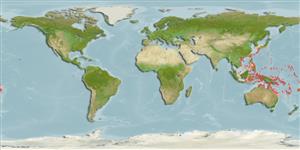Common names from other countries
>
Blenniiformes (Blennies) >
Tripterygiidae (Triplefin blennies) > Tripterygiinae
Etymology: Helcogramma: Greek, helkos, -eos, -ous = ulcer, sore + Greek, gramma = letter, mark (Ref. 45335).
More on author: Bleeker.
Environment: milieu / climate zone / depth range / distribution range
Ecología
marino asociado a arrecife; rango de profundidad 0 - 6 m (Ref. 58018). Tropical
Western Pacific: East Andaman Sea (Thailand), Malaysia (Tioman Island), Indonesia (Belitung, Komodo, Halmahera, and Banda Sea), Philippines (Luzon), Papua New Guinea (wewak), Solomon Islands, Vanuatu, and Taiwan.
Tamaño / Peso / Age
Maturity: Lm ? range ? - ? cm
Max length : 4.5 cm SL macho / no sexado; (Ref. 559)
Short description
Claves de identificación | Morfología | Morfometría
Espinas dorsales (total) : 16 - 18; Radios blandos dorsales (total) : 8 - 11; Espinas anales: 1; Radios blandos anales: 16 - 19. Trunk without longitudinal stripes; symphyseal dentary pores 3 or more; lateral line with fewer than 25 scales; anal fin with fewer than 19 rays; male with bluish white stripe from corner of jaw onto preopercle (Ref. 94457). Additional description: Dorsal fin III + XIII-XV + 8-11; anal fin I, 16-19; pectoral rays 16-17; pelvic fin I,2. Lateral line continuous, pored scales 21-29; head and narrow strip on upper back scaleless, nape with only a few scales. Mandibular sensory pores 3-8 + 3-9 + 3-8 (usually 3+3+3). Male greyish green, head ventrally black, cheek with blue horizontal stripe; body vertical bars H-shaped, brownish; zone between pectoral fin and operculum greenish grey. Female overall translucent, head marks brown, H-bars faint, fins translucent (Ref. 90102).
Adults inhabit coral and rocky bottoms at depths of 6 m and shallower (Ref. 90102). Eggs are hemispherical and covered with numerous sticky threads that anchor them in the algae on the nesting sites (Ref. 240). Larvae are planktonic which occur primarily in shallow, nearshore waters (Ref. 94114).
Life cycle and mating behavior
Maturities | Reproducción | Spawnings | Egg(s) | Fecundities | Larva
Masuda, H., K. Amaoka, C. Araga, T. Uyeno and T. Yoshino, 1984. The fishes of the Japanese Archipelago. Vol. 1. Tokai University Press, Tokyo, Japan. 437 p. (text). (Ref. 559)
IUCN Red List Status (Ref. 130435)
CITES (Ref. 128078)
Not Evaluated
Threat to humans
Harmless
Human uses
Herramientas
Special reports
Download XML
Fuentes de Internet
Estimates based on models
Preferred temperature (Ref.
115969): 24.7 - 29.3, mean 28.6 (based on 1714 cells).
Phylogenetic diversity index (Ref.
82804): PD
50 = 0.5000 [Uniqueness, from 0.5 = low to 2.0 = high].
Bayesian length-weight: a=0.01000 (0.00244 - 0.04107), b=3.04 (2.81 - 3.27), in cm Total Length, based on all LWR estimates for this body shape (Ref.
93245).
Nivel trófico (Ref.
69278): 3.1 ±0.3 se; based on size and trophs of closest relatives
Resiliencia (Ref.
120179): Alto, población duplicada en un tiempo mínimo inferior a 15 meses (Preliminary K or Fecundity.).
Fishing Vulnerability (Ref.
59153): Low vulnerability (10 of 100).
